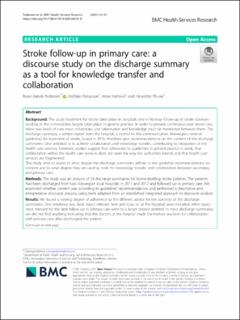| dc.contributor.author | Pedersen, Rune Aakvik | |
| dc.contributor.author | Petursson, Halfdan | |
| dc.contributor.author | Hetlevik, Irene | |
| dc.contributor.author | Thune, Henriette | |
| dc.date.accessioned | 2021-04-23T08:42:28Z | |
| dc.date.available | 2021-04-23T08:42:28Z | |
| dc.date.created | 2021-01-19T15:05:05Z | |
| dc.date.issued | 2021 | |
| dc.identifier.citation | BMC Health Services Research. 2021, 21, 1-12. | en_US |
| dc.identifier.issn | 1472-6963 | |
| dc.identifier.uri | https://hdl.handle.net/11250/2739284 | |
| dc.description.abstract | Background
The acute treatment for stroke takes place in hospitals and in Norway follow-up of stroke survivors residing in the communities largely takes place in general practice. In order to provide continuous post stroke care, these two levels of care must collaborate, and information and knowledge must be transferred between them. The discharge summary, a written report from the hospital, is central to this communication. Norwegian national guidelines for treatment of stroke, issued in 2010, therefore give recommendations on the content of the discharge summaries. One ambition is to achieve collaboration and knowledge transfer, contributing to integration of the health care services. However, studies suggest that adherence to guidelines in general practice is weak, that collaboration within the health care services does not work the way the authorities intend, and that health care services are fragmented.
This study aims to assess to what degree the discharge summaries adhere to the guideline recommendations on content and to what degree they are used as tools for knowledge transfer and collaboration between secondary and primary care.
Methods
The study was an analysis of 54 discharge summaries for home-dwelling stroke patients. The patients had been discharged from two Norwegian local hospitals in 2011 and 2012 and followed up in primary care. We examined whether content was according to guidelines’ recommendations and performed a descriptive and interpretative discourse analysis, using tools adapted from an established integrated approach to discourse analysis.
Results
We found a varying degree of adherence to the different advice for the contents of the discharge summaries. One tendency was clear: topics relevant here and now, i.e. at the hospital, were included, while topics most relevant for the later follow-up in primary care were to a larger degree omitted. In most discharge summaries, we did not find anything indicating that the doctors at the hospital made themselves available for collaboration with primary care after dischargeof the patient.
Conclusions
The discharge summaries did not fulfill their potential to serve as tools for collaboration, knowledge transfer, and guideline implementation. Instead, they may contribute to sustain the gap between hospital medicine and general practice. | en_US |
| dc.language.iso | eng | en_US |
| dc.publisher | BioMed Central, Springer Nature | en_US |
| dc.rights | Navngivelse 4.0 Internasjonal | * |
| dc.rights.uri | http://creativecommons.org/licenses/by/4.0/deed.no | * |
| dc.title | Stroke follow-up in primary care: a discourse study on the discharge summary as a tool for knowledge transfer and collaboration | en_US |
| dc.type | Peer reviewed | en_US |
| dc.type | Journal article | en_US |
| dc.description.version | publishedVersion | en_US |
| dc.source.pagenumber | 1-12 | en_US |
| dc.source.volume | 21 | en_US |
| dc.source.journal | BMC Health Services Research | en_US |
| dc.identifier.doi | 10.1186/s12913-020-06021-8 | |
| dc.identifier.cristin | 1874546 | |
| dc.description.localcode | © The Author(s). 2021.Open Access. This article is licensed under a Creative Commons Attribution 4.0 International License, which permits use, sharing, adaptation, distribution and reproduction in any medium or format, as long as you give appropriate credit to the original author(s) and the source, provide a link to the Creative Commons license, and indicate if changes were made. The images or other third party material in this article are included in the article's Creative Commons license, unless indicated otherwise in a credit line to the material. If material is not included in the article's Creative Commons license and your intended use is not permitted by statutory regulation or exceeds the permitted use, you will need to obtain permission directly from the copyright holder. To view a copy of this license, visithttp://creativecommons.org/licenses/by/4.0/.The Creative Commons Public Domain Dedication waiver (http://creativecommons.org/publicdomain/zero/1.0/) applies to the data made available in this article, unless otherwise stated in a credit line to the data. | en_US |
| dc.source.articlenumber | 41 | en_US |
| cristin.ispublished | true | |
| cristin.fulltext | original | |
| cristin.qualitycode | 2 | |

